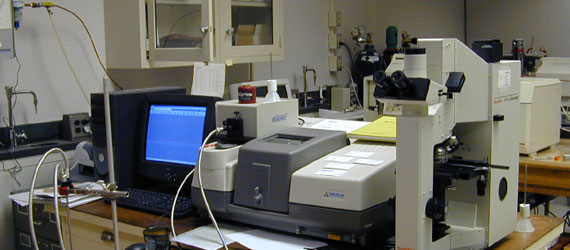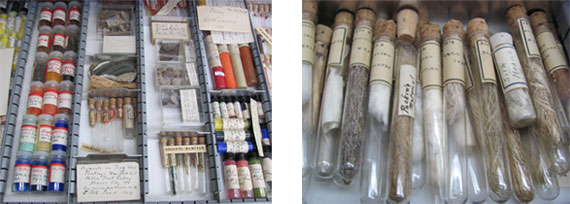
Fourier transform infrared spectrometer used for analysis of materials such as coatings, colorants, minerals, and degradation products.
Resources for scientific studies
Science can help answer questions relating to how and when an object was made, the history of an object, and its current condition and conservation needs. Studies of this type are crucial to our understanding of Asian material culture and how to preserve it. Research on artworks utilizes methods that are non-invasive, or require only a small sample. Most studies start with a thorough examination of an object using stereomicroscopy and ultraviolet light. Facilities for scientific research include laboratories for wet chemistry, instrumental analysis, microscopy, radiography, and scanning electron microscopy.
Analytical methods routinely used in our laboratory
Computed radiography (CR)
X-ray diffraction (XRD)
X-ray fluorescence spectroscopy (XRF)
Scanning electron microscopy with energy dispersive x-ray analysis (SEM/EDS)
UV-Visible reflectance spectroscopy (UV-Vis)
UV-Visible luminescence spectroscopy
Gas chromatography- mass spectrometry (GC-MS)
Fourier transform- infrared spectroscopy (FT-IR)
High-performance liquid chromatography (HPLC)
Optical, petrographic, and metallographic microscopy
Thermal analysis (DTA-TGA and TMA)
Reference collections

Left: Traditional Japanese pigments; Right: Plant fibers used in papermaking.
Both organic and inorganic materials used to create artworks are often not pure, well-defined chemical compounds. To aid the conservation scientist, reference collections of well-characterized materials are maintained for use in analytical procedures where data can help identify unknown materials of artworks, conservation materials, and the products of degradation. In addition, samples and results from previous studies are maintained as references.
- DCSR reference collection: more than 3,000 samples from a variety of sources available for comparison and analysis.
- Broad categories include: worked stone, resins, wood and lacquer, paper, ivory and fibers, organic media, shells and calcium minerals, gesso and gypsum, jade, chemical elements, copper minerals, oxides, sulfides, silicates and pigment minerals, metals, ceramics, glass, painting samples, efflorescence samples, pigment samples
- Samples from the Forbes pigment collection: colorants assembled by the late Edward Waldo Forbes, former director of the Fogg Art Museum at Harvard University (1909–45)
- Colorants: more than 1,600 nineteenth- and twentieth-century colorants from a variety of sources in Asia and the West
- More than 400 mounted metallographic cross-sections of Asian metals
- Botanical materials from Southeast Asia collected by Rosemary Gianno (see Gianno, R. Resin Classification among the Semelai of Tasek Bera, Pahang, Malaysia, Economic Botany 40 (2), 1986, 186–200).
- X-ray diffraction film collection: more than 4,000 XRD films of a broad range of samples from objects, including pigments, corrosion products, minerals, etc.
- A collection of samples of accessioned objects and comparative materials, including materials retained after analyses and those resulting from conservation treatments
- A collection of prepared microscope slides of colorants from museum objects
- An off-print file devoted to articles on the scientific analysis of Asian art, providing access to rare or hard-to-find publications.
Scientific Research
OverviewTech Lab
Resources for scientific studies
Research
Forbes program
Forbes Symposium
About the Department
Conservation
The conservation staff at the Freer and Sackler Galleries is responsible for the preservation and treatment of artworks in the collection, as well as preparing these objects for exhibition. The Department of Conservation and Scientific Research includes sections devoted to East Asian Paintings, Objects, Paper, and Exhibitions. More info »
Staff Publications
Publication is an integral part of our research program. Click below to view lists of published works by past and present members of the department: